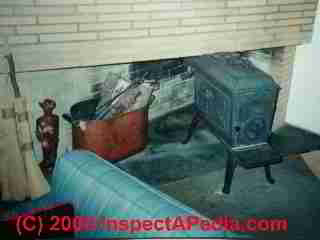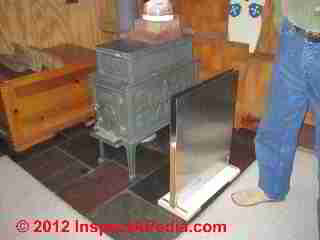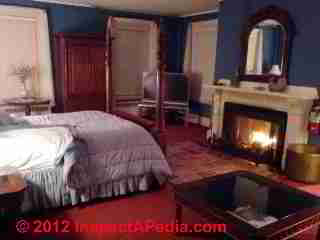 Fireplace & Woodstove vs Indoor Air Quality
Fireplace & Woodstove vs Indoor Air Quality
- POST a QUESTION or COMMENT about fireplaces & woodstoves as sources of indoor air quality problems, dust, odors, & hazards: detection, cause, remedy
Fireplace or woodstove odors, smells, & dust or soot problems in buildings:
This article explains the impact of fireplaces or woodstoves on indoor air quality in homes. We explain what causes these complaints and we describe how to prevent them.
InspectAPedia tolerates no conflicts of interest. We have no relationship with advertisers, products, or services discussed at this website.
- Daniel Friedman, Publisher/Editor/Author - See WHO ARE WE?
Guide to Fireplaces & Woodstoves as Sources of Indoor Air Pollutants
This article includes excerpts or adaptations from Best Practices Guide to Residential Construction (Steve Bliss, J Wiley & Sons) , by Steven Bliss, courtesy of Wiley & Sons. According to Best Practices Guide to Residential Construction :
Traditional open fireplaces and older leaky woodstoves burn very inefficiently and produce hundreds of chemical compounds, including carbon monoxide, organic gases, particulates, and some of the same cancer-causing agents found in tobacco smoke.
Minor spillage of these pollutants occurs regularly, primarily when starting or stoking the fire.
However, the larger concern is when the fire smolders late at night, producing high levels of CO and a weak draft. Backdrafting at this time can be dangerous or even fatal.
Another problem, particularly with fireplaces, is created when the fire is roaring and drawing up to 400 cfm of combustion air.
At this point, its voracious appetite for air can cause backdrafting in other combustion appliances such as a gas water heater.
Also, the need to reheat all the makeup air drags down the fireplace’s heating efficiency to less than 15% and, if the fireplace is allowed to smolder all night, it becomes a net heat loser.
The Jotul woodstove shown at below was traded by the author for a wristwatch. The new owner installed the stove including a fireproof tile-covered barrier between the stove and a nearby building wall. The owner later added the metal heat reflector to the right of the stove to adjust room comfort and heat movement.
Photo courtesy Paul Galow. That woodbox is too close - less than 36" from the woodstove.
Woodstove efficiency has improved dramatically in response to EPA emissions standards (begun in 1988 and updated in 1990), which apply to most freestanding wood stoves and to fireplace inserts with air-supply controls and tight-fitting doors.
To meet these standards, manufacturers use either a catalytic converter, similar to the ones used in cars, or a reengineered firebox.
The new fireboxes have primary and secondary combustion zones capable of reaching system efficiencies of 60% or more and reducing combustion air intake to as little as 10 cfm. If installed with an outdoor air supply, these can be successfully de- coupled from household air pressures.
While many fireplaces are fitted with glass doors, and some have outside air intakes, nearly all of the glass doors leak air. Even with low levels of depressurization, these fireplaces can still backdraft, and the fireplace’s outdoor air supply might become the makeup air for the kitchen range hood or other exhaust fans, drawing fireplace fumes along with it. The best solution is an airtight fireplace insert.
How to minimize pollution, indoors and outside, from wood-burning appliances
- Choose a properly sized stove or insert certified as meeting EPA emissions standards.
- Make sure the door gaskets are in good shape, the doors fit tightly, and the stove is free of air leaks.
- Make sure the flue is the correct diameter and height, and have it inspected and cleaned annually.
- Use wood that has been split and dried for at least six months. Try to use small pieces, and do not overload the firebox. Leave enough room for air to circulate freely around the wood.
- For safety purposes, install a smoke alarm and carbon monoxide detector in the same room as the woodstove or fireplace.
-- Adapted with permission from Best Practices Guide to Residential Construction (Steve Bliss, J Wiley & Sons) .
Watch out: several of our clients report, and tests confirmed horrible building odor problems after excessive use of ozone as a "cure" for fireplace or woodsmoke or creosote odors in buildings.
Excessive or improper use of ozone as an "odor killer" in such situations can lead to oxidation of other building materials that then give off chemical or plastic odors that cannot be cured without removing and replacing the materials affected.
See OZONE HAZARDS for details.
...
Continue reading at FIRE & SMOKE ODOR REMOVAL or select a topic from the closely-related articles below, or see the complete ARTICLE INDEX.
Or see
AIR POLLUTANTS, COMMON INDOOR and also see AIR POLLUTANTS HEALTH EFFECTS
FIREPLACES & HEARTHS - home
Suggested citation for this web page
FIREPLACE & WOODSTOVE CONTAMINANTS at InspectApedia.com - online encyclopedia of building & environmental inspection, testing, diagnosis, repair, & problem prevention advice.
Or see this
INDEX to RELATED ARTICLES: ARTICLE INDEX to CHIMNEYS & FLUES
Or use the SEARCH BOX found below to Ask a Question or Search InspectApedia
Or see
INDEX to RELATED ARTICLES: ARTICLE INDEX to BUILDING INDOOR AIR QUALITY IAQ
Or use the SEARCH BOX found below to Ask a Question or Search InspectApedia
Ask a Question or Search InspectApedia
Questions & answers or comments about fireplaces & woodstoves as sources of indoor air quality problems, dust, odors, & hazards: detection, cause, remedy..
Try the search box just below, or if you prefer, post a question or comment in the Comments box below and we will respond promptly.
Search the InspectApedia website
Note: appearance of your Comment below may be delayed: if your comment contains an image, photograph, web link, or text that looks to the software as if it might be a web link, your posting will appear after it has been approved by a moderator. Apologies for the delay.
Only one image can be added per comment but you can post as many comments, and therefore images, as you like.
You will not receive a notification when a response to your question has been posted.
Please bookmark this page to make it easy for you to check back for our response.
IF above you see "Comment Form is loading comments..." then COMMENT BOX - countable.ca / bawkbox.com IS NOT WORKING.
In any case you are welcome to send an email directly to us at InspectApedia.com at editor@inspectApedia.com
We'll reply to you directly. Please help us help you by noting, in your email, the URL of the InspectApedia page where you wanted to comment.
Citations & References
In addition to any citations in the article above, a full list is available on request.
- Paul Galow [Website galowconsulting.com ] - technical consultant on networking, LAN design, applications support. Galow Consulting Services [Website galowconsulting.com ] , 914-204-1749, email: paulgalow@galowconsulting.com
- Our recommended books about building & mechanical systems design, inspection, problem diagnosis, and repair, and about indoor environment and IAQ testing, diagnosis, and cleanup are at the InspectAPedia Bookstore. Also see our Book Reviews - InspectAPedia.
- Decks and Porches, the JLC Guide to, Best Practices for Outdoor Spaces, Steve Bliss (Editor), The Journal of Light Construction, Williston VT, 2010 ISBN 10: 1-928580-42-4, ISBN 13: 978-1-928580-42-3, available from Amazon.com
- In addition to citations & references found in this article, see the research citations given at the end of the related articles found at our suggested
CONTINUE READING or RECOMMENDED ARTICLES.
- Carson, Dunlop & Associates Ltd., 120 Carlton Street Suite 407, Toronto ON M5A 4K2. Tel: (416) 964-9415 1-800-268-7070 Email: info@carsondunlop.com. Alan Carson is a past president of ASHI, the American Society of Home Inspectors.
Thanks to Alan Carson and Bob Dunlop, for permission for InspectAPedia to use text excerpts from The HOME REFERENCE BOOK - the Encyclopedia of Homes and to use illustrations from The ILLUSTRATED HOME .
Carson Dunlop Associates provides extensive home inspection education and report writing material. In gratitude we provide links to tsome Carson Dunlop Associates products and services.




